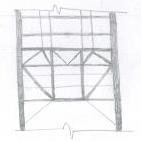-
Posts
15 -
Joined
-
Last visited
Reputation Activity
-
 Shamim Ahmmed reacted to Ayesha in Steel Design by ASD or LRFD?
Shamim Ahmmed reacted to Ayesha in Steel Design by ASD or LRFD?
ASD is an older method that is still practised by a lot of mechanical engineers to size pressure vessels and tanks. However, for structural engineering, everywhere, LRFD is used. Here is a detailed answer I read once somewhere on the internet and saved it as it was very interesting.
-
 Shamim Ahmmed got a reaction from Badar (BAZ) in Why Longitudinal Reinforcement is larger in upper story than bottom story.
Shamim Ahmmed got a reaction from Badar (BAZ) in Why Longitudinal Reinforcement is larger in upper story than bottom story.
Thank you Sir @BAZ
I got the point, why Longitudinal reinforcement increasing, Due to M2-2 & M-33 is greater in Upper story than Lower.
But another question arrived in my mind why upper story M2-2 @ M3-3 is larger than bottom? File Attached.
though I assigned less load in Upper story than Bottom story beam and slab.
No Wind & earthquake load applied.
Please Explain me.
-
 Shamim Ahmmed reacted to WR1 in Column Reinforcement
Shamim Ahmmed reacted to WR1 in Column Reinforcement
Yes, nothing wrong in it. It depends on design. More reinf at upper levels could be due to more moment and less axial loads.
-
 Shamim Ahmmed reacted to Waqar Saleem in Etabs modelling Technique
Shamim Ahmmed reacted to Waqar Saleem in Etabs modelling Technique
Salam
if we have basement, should we define story for base shear from ground to roof or base to roof.
Regards
-
 Shamim Ahmmed reacted to Waqar Saleem in Understanding Reinforcement Output ETABS
Shamim Ahmmed reacted to Waqar Saleem in Understanding Reinforcement Output ETABS
Wasalam,
Dear Shamim,
These are basics of RCC design to know the required reinforcements, if reinf %age is 2.3%, your column size is 12"x12"(say) you will get longitudinal reinforcement as 2.3x12x12/100 = 3.312 in^2, now you can convert this 3.312 into different number of bars, if you are using #6 bars its area is 0.44in^2, Number of #6 rebars= 3.312/.44 = 7.52 make it 8 #6 bars as longitudinal bars in RCC Column.
Regards
-
 Shamim Ahmmed reacted to Waqas Haider in R/f at top in isolated footing
Shamim Ahmmed reacted to Waqas Haider in R/f at top in isolated footing
Top reinforcement is needed in isolated footing majorly for two reasons.
1) Due to negative pressure under some or whole part of footing. In part of footing where there is positive pressure, the footing is in complete contact with soil and tension is in bottom side of footing. But in part of footing where there is negative pressure the footing is no more in contact with ground. Either it is designed as it is (and reduced contact area is used for calculations) or it is made to become in contact with ground by help of over burden loads. In either case, the bending of footing is in such a way which causes tension of footing at top of foundation demanding top reinforcement in footing. Mostly top reinforcement is less than bottom reinforcement but for simplicity, if it is not affecting economy much same reinforcement can also be used for top and bottom.
2) Due to temperature and shrinkage control. Code says we can provide temperature based minimum steel either in one layer at center or at any face or we can divide total steel in two layers i.e. half at top face and half at bottom. According to Zahid Ahmad Siddique (Professor at UET Lahore) in his book concrete structures mentions it is better to provide temperature steel in two layers if thickness of footing increases 18 inch.
-


